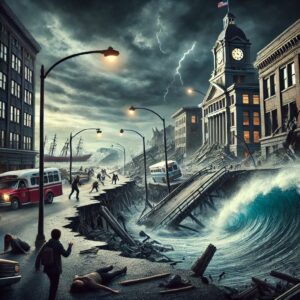On March 27, 1964, Alaska was rocked by the most powerful earthquake ever recorded in the United States—a staggering 9.2-magnitude tremor that sent shockwaves across the region. Known as the Great Alaska Earthquake, this massive quake lasted an astonishing four and a half minutes, causing widespread destruction and triggering deadly tsunamis. Entire towns were swallowed by landslides, buildings crumbled like sandcastles, and the land itself was permanently reshaped. The devastation was unlike anything Alaskans had ever seen, leaving behind a haunting reminder of nature’s raw power.
The earthquake’s epicenter was located in Prince William Sound, about 75 miles east of Anchorage. What made this quake particularly catastrophic was the combination of violent ground shaking and secondary disasters. As the earth convulsed, vast sections of land were thrust upwards or dropped several feet, permanently altering Alaska’s landscape. The shaking alone caused landslides that buried homes, businesses, and roadways, while the subsequent tsunamis devastated coastal communities as far away as California and Hawaii. Valdez, a key port town, was obliterated as a massive wave engulfed the harbor, sweeping away docks, ships, and buildings.
The human toll of the disaster was severe. More than 130 people lost their lives, primarily due to the towering tsunamis that followed the quake. While Alaska’s sparse population prevented even greater casualties, the economic impact was staggering. Infrastructure across the state was shattered—Anchorage, Alaska’s largest city, saw entire neighborhoods collapse, while bridges, railways, and oil facilities were torn apart. The disaster led to new advancements in earthquake research and building codes, shaping the way the U.S. prepares for future seismic events.
The Great Alaska Earthquake of 1964 remains one of the most significant natural disasters in American history. It served as a grim reminder of the Pacific Ring of Fire’s relentless seismic activity and the unpredictable nature of earthquakes. Today, its lessons continue to influence engineering, emergency response, and geological studies, helping to protect future generations from the earth’s unpredictable fury.

